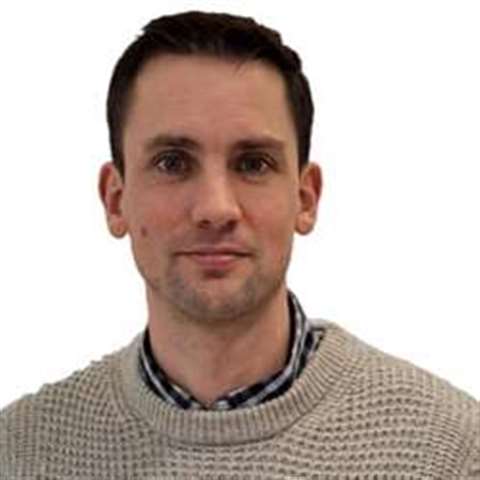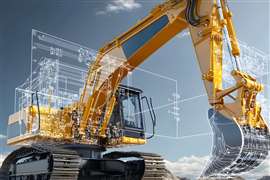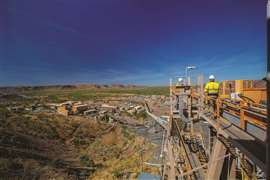Read this article in 中文 Français Deutsch Italiano Português Español
Doka at bauma: automation in the field, data in the cloud, and less waste everywhere
15 April 2025
At bauma 2025, Doka CEO Robert Hauser provided Construction Briefing a unique, hands-on tour of the company’s latest innovations: From automation to low-carbon concrete support and recycled formwork materials, Hauser painted a picture of a company aligning its future with efficiency and sustainability.
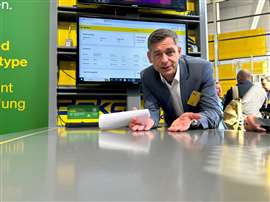 Doka CEO Robert Hauser discusses his company’s latest innovations at bauma 2025. (Image: Mitchell Keller)
Doka CEO Robert Hauser discusses his company’s latest innovations at bauma 2025. (Image: Mitchell Keller)
“Productivity in construction hasn’t really improved in decades,” Hauser tells the Briefing. “The cost of construction is too high, so we have to change that.
“We have to increase productivity, lower cost and make sites safer.”
Automating the core, Doka’s robotic systems
At the centre of the effort are an automated climbing formwork system with a next-gen control and drive system that allows formwork to be lifted and adjusted at the touch of a button and two robots; all on display at the forefront of the Austria-based formwork and scaffolding manufacturer’s booth at bauma, as part of its Smart Construction Outdoor area.
One robot was showcased alongside Doka’s LeanForm system – a site-adjacent production method that brings modular, factory-like efficiency to the assembly of wall formwork. Instead of constructing wall forms at height – where access and safety are more challenging – crews set up a designated work area next to the building. There, complete formwork units are assembled with rebar, box-outs, and anchoring hardware.
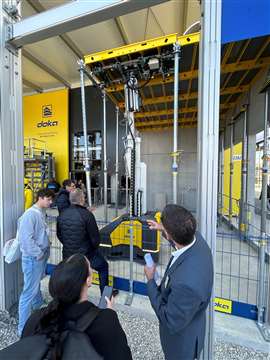 Doka CEO Robert Hauser explains the group’s DokaXdek slab lifting system at bauma. (Image: Mitchell Keller)
Doka CEO Robert Hauser explains the group’s DokaXdek slab lifting system at bauma. (Image: Mitchell Keller)
As part of ongoing development, Doka has introduced a robotic arm prototype – the DokaXbot Lift – within this system to assist with repetitive or precision-based tasks, such as placing anchors. Once a section is fully assembled, it’s craned into position on the structure, ready for concrete pouring. LeanForm has already been used on jobsites, while the robotic integration is still in pilot testing.
Hauser said the goal of Doka Lean Form and companion robotic prototype are to simplify labour at height, reduce cycle times, and improve consistency.
“By using that building place and the robot, you can realise efficiency gains of 20 to 30%,” he said. “And we didn’t just calculate it – we tested it in real life.”
The second robot, DokaXBot Lift, is part of the company’s DokaXdek system – a slab formwork solution that includes a panel-handling robot capable of lifting panels up to 6m high. The machine can also install heavy props as part of a single, integrated movement. The panel is roughly pre-positioned safely from the ground by remote control, the fine positioning is then automatically done by the DokaXbot Lift. Thus, the unit currently requires manually guiding the slab into final position, but the heavy-lifting is automated, and Hauser suggested full autonomy isn’t far off.
“You could picture a situation where the robot erects the formwork overnight,” he said.
Hauser said both robots will soon enter testing on active jobsites in collaboration with selected customers.
Concrete curing in the bitter cold? Doka says, ‘no problem’
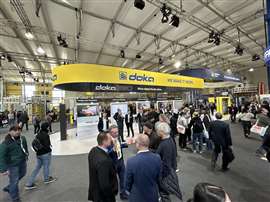 Doka at bauma 2025 (Image: Doka)
Doka at bauma 2025 (Image: Doka)
Another area where Doka is seeking increased productivity (and in a sustainability segment) is in the curing of low-emission concrete. These novel construction materials are hitting the market but tend to behave differently than traditional mixes, especially in cold conditions.
At bauma, Doka presented its Intelligent Heated Formwork – a flat, reusable system that incorporates a built-in heating material integrated in the plywood. Designed to accelerate the curing of concrete in cold environments, the table initiates and regulates heat during the early stages of concrete placement, helping achieve target strength more quickly.
The heated formwork allows the system to maintain curing temperatures efficiently, even in sub-zero conditions.
The system also integrates with Doka’s Concremote sensor platform, giving crews real-time data on temperature and curing progress – and providing accurate forecasts on when forms can be safely stripped. It calculates required curing temperatures based on concrete mix, ambient conditions, and time targets, with CO₂ comparisons built into the interface.
“New concretes don’t cure as fast... in low temps,” said Hauser. “This way, you start the curing, monitor it, and adjust the temperature as needed.”
Pavel Kasal, product manager of digital services at Doka, shared details of a project in Sweden that recently used the prototype system in extreme conditions: –20°C temps.
“We started the mid of February, and when I was on the construction site, it was minus 15,” he said. “Normally they use disposable cables that they put under the reinforcement... but they decided to test heated formwork and they are quite satisfied.”
Additionally, instead of heating the entire site via an enclosure with oil burners, the contractor used heated formwork panels for curing, reducing energy consumption and enabling next-day stripping.
Doka’s composite sheet: lighter than wood with a long life
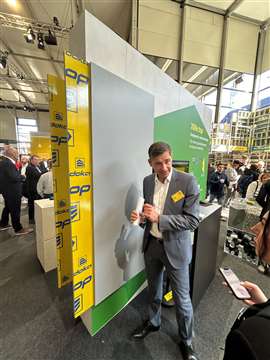 Robert Hauser, Doka CEO, showcases the compnay’s recycled plastic sheet formwork solution: Xlife. (Image: Mitchell Keller)
Robert Hauser, Doka CEO, showcases the compnay’s recycled plastic sheet formwork solution: Xlife. (Image: Mitchell Keller)
Also debuting at bauma was the Xlife top sheet, Doka’s new high-durability formwork sheet. Its core is made entirely from recycled consumer plastic.
Designed for long life and full recyclability, the sheet is part of a closed-loop system – once it reaches the end of its use phase, it can be shredded, reprocessed, and turned back into new sheets.
“This sheet – we expect a long-lasting lifetime,” he said.
Constructed with layers of fabric and recycled plastic, the sheet includes air pockets that reduce weight without compromising strength.
It’s also resistant to water, weather, and mechanical wear, making it better suited to harsh environments than traditional wood-based sheets. Hauser added that it can even be repaired mid-life – for example, if damaged by nails – and returned to service.
“This is a perfect example of where sustainability benefits and economic benefits come together,” he said.
Getting the 360-view with Doka’s customer platform
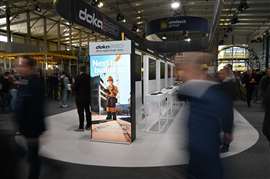 The Doka 360 stand and display at bauma 2025. (Image: Doka)
The Doka 360 stand and display at bauma 2025. (Image: Doka)
Each of these innovations – robots, heating systems, material advances – will connect back into a single ecosystem: the Doka 360 customer platform.
Developed in-house with Umdasch Group (Doka’s parent company), the digital interface brings everything from planning to tracking, ordering, and site monitoring under one login.
“You can interact with Doka purely through the platform,” Hauser said. “It’s seamless – design, logistics, delivery, returns.” Hauser said it simplifies orders for customers, which frees up Doka sales members to engage clients on more complex projects.
Magdalena Auer, digital strategy and transformation manager at Umdasch Group, demonstrated how Doka 360 gives site managers a cockpit view of all active projects, integrates sensor data, and connects to planning tools and the online shop.
“Everything you do in your relationship with Doka,” she said, “is central and transparent in the platform.”
It also includes curing alerts, material status updates, and predictive tools for return and reuse.
Doka 360 is entering early access in July 2025, with rollout in Europe and North America to follow.
Taken altogether, Doka’s bauma showcase signals more than product launches – it reflects a broader shift in how the company sees its role on the construction site.
From automation and low-carbon curing to digital coordination and recyclable materials, the aim is not just to optimise individual tasks, but to rethink the entire jobsite process.
Particularly when wrapped into an in-house software platform like Doka 360, Hauser sees opportunities for customers to be “more efficient, [with] just one interface where you have everything at your fingertips.”
STAY CONNECTED


Receive the information you need when you need it through our world-leading magazines, newsletters and daily briefings.
CONNECT WITH THE TEAM

